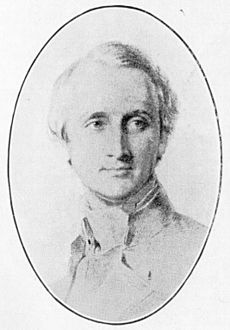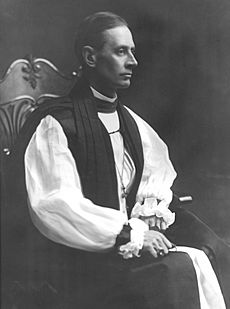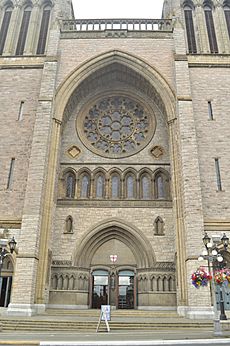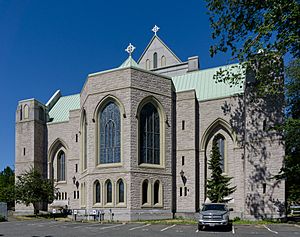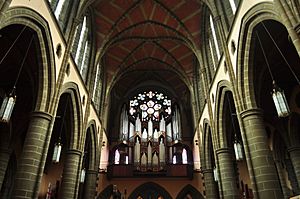Christ Church Cathedral (Victoria, British Columbia) facts for kids
Quick facts for kids Christ Church Cathedral |
|
|---|---|
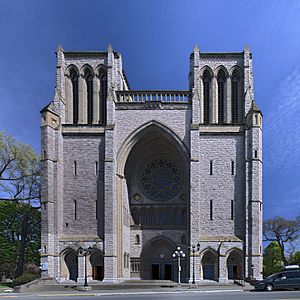
Christ Church Cathedral
|
|
| 48°25′20″N 123°21′33″W / 48.42222°N 123.35917°W | |
| Location | 930 Burdett Avenue Victoria, British Columbia V8V 3G8 |
| Denomination | Anglican Church of Canada |
| Website | http://www.christchurchcathedral.bc.ca/ |
| Administration | |
| Deanery | Tolmie |
| Diocese | British Columbia |
| Province | British Columbia and Yukon |
Christ Church Cathedral in Victoria, British Columbia is a very important church. It is the main church for the Anglican Church of Canada in the area.
Contents
History of the Cathedral
The First Church (1856–1869)
The first church building was finished on August 31, 1856. It was known as the Victoria District Church. In 1858, many gold seekers came to Victoria because of the Fraser Canyon Gold Rush. The town grew very quickly.
In 1859, George Hills became the first Bishop of British Columbia. He arrived in Victoria in 1860. Bishop Hills decided that Christ Church would be the main church, or "cathedral." This happened on December 7, 1865.
Sadly, on September 30, 1869, the first cathedral burned down completely. Luckily, some important items like the communion cups and the organ were saved. The church used another building for services while they planned to rebuild.
The Second Church (1872–1929)
The foundation stone for the new church was laid on May 20, 1872. This new building was also made of wood. It was about 100 feet (30 meters) long and 50 feet (15 meters) wide, with a tower that was 78 feet (24 meters) tall. It took about six months to build.
A Big Disagreement in 1874
There was a big disagreement between the first dean, Edward Cridge, and Bishop Hills. Cridge did not always agree with the Bishop's rules. This led to a public argument in 1872.
The disagreement went to a special church court. On September 22, 1874, Cridge was found guilty of several charges. His permission to be a priest was taken away.
Many people in the church supported Cridge. They decided to form a new church group called the Church of Our Lord. This new church was part of a different group called the Reformed Episcopal Church.
The Current Church (1929–Present)
The wooden church built in 1872 eventually became too small. In 1891, a competition was held to design a new, bigger church made of stone. The winning design was by J.C.M. Keith. It was in a Gothic style, like churches from the 13th century.
It took a long time to raise enough money. Construction finally began in 1926. Charles Schofield, who became bishop in 1916, was very important in leading this project.
Building the Cathedral
The first part of the new cathedral was finished on September 28, 1929. This included the main part of the church (the nave), the entrance area (narthex), and the lower parts of the two front towers. A temporary wooden wall closed off the east end.
A famous visitor, Winston Churchill, came to the site on September 9, 1929. He even helped lay a stone on the north tower!
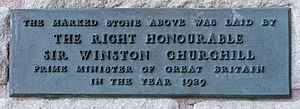
During construction, a robin built its nest on the scaffolding near a main pillar. Workers waited until the baby birds had left the nest before continuing work in that area. Later, a stone sculpture of the robin and its nest was placed on top of that pillar.
In 1936, eight large bells were bought and installed in the north-west tower. These bells were made in London, England, and are similar to the bells at Westminster Abbey. They weigh a lot – eight tons of steel and seven and a half tons of bells! They were first rung on July 12, 1936.
In 1952, a special room for ashes (a columbarium) was built under the main part of the church. In 1957, the western towers and the arch over the rose window were completed.
Changes Since Completion
Over the years, the cathedral has had many updates. In 1983, two smaller bells were added to the set of eight. These new bells were dedicated on March 8, 1983, with Elizabeth II and Prince Philip, Duke of Edinburgh present. One bell is named after Mr. Izard, who led the bell ringing for many years. The other is named after Prince William, Duke of Cambridge.
In 1985, the temporary wooden wall at the east end was replaced. A new stone-covered addition was built, which included a chapel and other rooms.
In 1997, the brick ceilings were strengthened to make the building safer in case of an earthquake.
In 2005, a brand new, large pipe organ was installed. This was a big project that took several years to complete.
In June 2019, the Cathedral became a partner in the Community of Cross of Nails. This group was started by Coventry Cathedral after it was destroyed in World War II. Christ Church now has a special Chapel of Reconciliation and a Cross of Nails, which reminds people about peace and forgiveness.
Deans of Columbia
The Dean of Columbia is also the leader of Christ Church Cathedral in Victoria. Here are some of the past and current Deans:
- 1860–1874: Edward Cridge (the first Dean)
- 1876: Sam Gilson
- 1878–1881: George Mason
- 1881–1892: The Bishop took on these duties
- 1910–1914: Alexander Doull
- 1915–1916: Charles Schofield (later became Bishop)
- 1917–1937: Cecil S. Quainton
- c.1945: Spenser Elliot
- 1949–1952: George Calvert
- 1952–1955: Philip Beattie
- 1955–1980: Brian William Whitlow
- 1981–1995: John Timothy Frame
- 1996–2005: John Wright
- 2006–2015: Logan McMenamie (later became Bishop)
- July 2015–2022: Margaret Ansley Tucker
- September 2024–present: Jonathan Thomas
Organists
Here are some of the people who have played the pipe organ at the cathedral:
- Stanley Bulley
- Graham Percy Steed
- Richard Proudman
- Beal Thomas
- Canon Michael Gormley
- Donald Hunt


